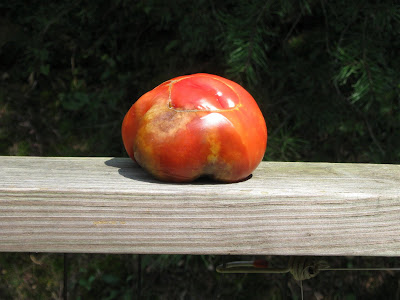My Irish blood rose a bit after I read a New York Times article that talked about the blight that is hitting the Northeastern part of country. It was slanted in such a way that the local home gardeners came out as the bad guys. He presented this, "bad guy" argument based on assumptions.
In case you haven't heard there is a tomato blight that is hitting not only the Northeast but also my part of central Kentucky.
It is the same type of fungus blight that hit Ireland in the mid-1800s which resulted in the potato famine that lasted for six years and caused untold deaths from starvation. Of course the Irish at that time were using mono-cropping methods for their potatoes. It was their main source of food and they ate it morning, noon, and night. This meant there were a lot of potatoes being grown. They grew these potatoes year after year with no diversity. The tomato being in the same family as the potato might be suffering from this same situation -- large scale mono-cropping by agri-business or also called corporate farming with no diversity. Being in the same family as the potato the tomato was being set up for the blight to hit.
More about this later. First I want to tell you about my personal experience with the blight.
 MY TOMATO PLANT LEAVES A WEEK AFTER THE BLIGHT HIT IT -AUGUST
MY TOMATO PLANT LEAVES A WEEK AFTER THE BLIGHT HIT IT -AUGUSTI didn't know what it was at first. But I knew it was serious. I picked off all the green tomatoes and brought them in to ripen. At that point some of the green tomatoes had a few brown spots. I had hoped that I could still use them. But for some reason they turned red faster than usual compared to picking them green in late fall, The brown spots kept appearing with speed and then came the white fungus. I finally found out that I had the Irish tomato blight from my mailman who is a wonderful local gardener.
My blight hit fast and took down the tomato plants in about a week. At least that is what happened to mine and others that I know in Kentucky. The end result is a sickly looking plant that had big and beautiful tomatoes before it began to die. It begins with soft brown spots around the tomato. At the same time as the brown spots are showing, the leaves begin to turn yellow then dark brown and whither on the vine. All new blooms fall off or I should say shrivel off. At that point your plant is a sure, "gonner." And it spreads to every tomato plant in your garden quickly. If you leave your tomatoes on the plant they also begin to get a white fungus growing out from the brown spots.
I found out that composting the tomatoes will spread the disease. You need to put them in a plastic bag and dispose of them in your trash.
I found out that composting the tomatoes will spread the disease. You need to put them in a plastic bag and dispose of them in your trash.
 HEALTHY HEIRLOOM TOMATO I BOUGHT FROM A LOCAL FARMER IN AUGUST
HEALTHY HEIRLOOM TOMATO I BOUGHT FROM A LOCAL FARMER IN AUGUSTNow not everyone has been hit by the blight in this area although many have. Above is a local tomato that I just bought this week at the Farmers market. This farmer lives far out in the boonies -- don't know if that makes her untouchable or not.
 SOME OF MY VERY HEALTHY TOMATO PLANTS MIXED WITH ZINNIAS AND SUNFLOWERS END OF JUNE
SOME OF MY VERY HEALTHY TOMATO PLANTS MIXED WITH ZINNIAS AND SUNFLOWERS END OF JUNEGetting back to the New York Times article. The author, Dan Barber, seemed to be trying to figure out what made the blight suddenly appear. He offered up several ideas. But the main one was that local home gardnerers bought their seelings from big box stores. The box stores had seedlings with blight and therefore the home gardeners were the transporters of the disease.
He goes on to argue that big box stores buy from commercial nurseries that disperse the seedlings over many miles to the area stores. So, who is the transporters -- sounds like the commercial nurseries not the local gardeners.
He doesn't give a thought to where the commercial mono-crop growers buy their seedlings! He doesn't mention that commercial growers do not have any diversity in growing their tomatoes -- just acres of the same thing -- tomatoes. The same goes for commercial nurseries -- they grow mono-seedlings without diversity.
Local home gardens have diversity in their gardens unlike corporate farms. Many locals grow from seeds -- not always with seedlings from big box stores.
Corporate growing with their hundreds of acres of one type of crop can set up major disease in a hurry if the conditions are right. Or even corporate growing with contaminated (blight) seedlings can spread the disease. Deju vous from Ireland.
One thing I did agree with in his article was that excessive rain and cool, humid weather could foster blight. But my feelings are you need a major outbreak of blight to unbalance nature. Like the Irish famine of mono-cropped potatoes we have too many mono-cropping corporate farms growing only tomatoes.
Mr. Dan Barber of the New York Times, give us local gardnerers a break! Look in the corporate backyard not ours.
He goes on to argue that big box stores buy from commercial nurseries that disperse the seedlings over many miles to the area stores. So, who is the transporters -- sounds like the commercial nurseries not the local gardeners.
He doesn't give a thought to where the commercial mono-crop growers buy their seedlings! He doesn't mention that commercial growers do not have any diversity in growing their tomatoes -- just acres of the same thing -- tomatoes. The same goes for commercial nurseries -- they grow mono-seedlings without diversity.
Local home gardens have diversity in their gardens unlike corporate farms. Many locals grow from seeds -- not always with seedlings from big box stores.
Corporate growing with their hundreds of acres of one type of crop can set up major disease in a hurry if the conditions are right. Or even corporate growing with contaminated (blight) seedlings can spread the disease. Deju vous from Ireland.
One thing I did agree with in his article was that excessive rain and cool, humid weather could foster blight. But my feelings are you need a major outbreak of blight to unbalance nature. Like the Irish famine of mono-cropped potatoes we have too many mono-cropping corporate farms growing only tomatoes.
Mr. Dan Barber of the New York Times, give us local gardnerers a break! Look in the corporate backyard not ours.


No comments:
Post a Comment